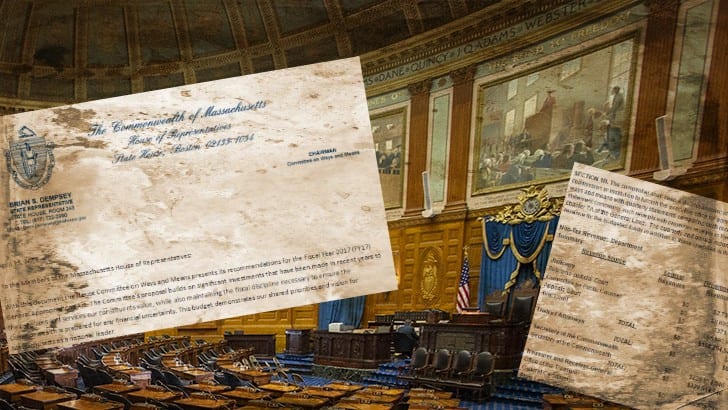
June 28, 2016
BY JASON PRAMAS @JASONPRAMAS
If you think that the Commonwealth of Massachusetts and the City of Boston lavishing $270 million in tax breaks and direct aid on General Electric in exchange for moving their world headquarters to the Hubis unconscionable, you should realize that the deal is only a more extreme example of the existing government gravy train for corporations hereabouts. In fact, to focus on but one of several programs that give public money away to businesses for dubious reasons, the state government is already able to dole out a total of $30 million in Economic Development Incentive Program (EDIP) tax credits each year to all approved corporate applicants.
But that’s apparently not enough for Charlie Baker. The governor sponsored an economic development bill in January (H.4413, formerly H.3983) that will allow the EDIP cap to be boosted to $50 million a year whenever another big GE-style deal is in the offing. And with the House expected to vote on it this week and the Senate next week, the proposed legislation is well on its way to passage.
The tax credits in question are approved by the Economic Assistance Coordinating Council (EACC)—a14-member board consisting of seven gubernatorial appointees (representing six regions of the Commonwealth and one institution of higher education) and seven high-level state government officials (one of those seats being currently vacant). The EACC meets quarterly to approve EDIP credits, and local Tax Increment Financing (TIF) credits proposed by qualified municipalities.
Interestingly, as reported in the Boston Business Journal, General Electric did not go for EDIP tax credits to help finance its new world headquarters in Boston. “It’s not necessarily that GE did not want EDIP credits or that the state felt infrastructure grants alone were the most attractive package, according to [Mass Secretary of Housing and Economic Development Jay] Ash. It’s that the state’s options for GE under the current incarnation of EDIP were limited.”
Baker’s economic development bill would make things significantly less limited for companies like GE —or, as the press buzz would have it, for the “next General Electric.” Because the already undemocratic EDIP process, overseen as it is by unelected staffers and appointees on the EACC, would be made even more undemocratic in the case of what the bill calls an “extraordinary economic development opportunity.” In a manner that CEOs on the make will find most advantageous.
And what exactly is an extraordinary economic development opportunity? It’s the situation that arises when a giant corporation like GE wants extraordinary amounts of state money to site facilities in the Commonwealth. To paraphrase the bill, if the secretary of the Executive Office of Housing and Economic Development and the secretary of the Executive Office for Administration and Finance agree that a corporation is going to build or rehabilitate a significant facility in Massachusetts, or relocate a business to Mass from a facility outside the Commonwealth—and either create at least 400 new jobs, or create at least 200 new jobs in a “gateway municipality” (state government speak for an economically depressed city) or in an adjacent city or town that is accessible by public transportation to residents of a gateway municipality—then it can be declared an extraordinary economic development opportunity and become eligible for much bigger EDIP tax credits than have been allowed heretofore. So large that the EEAC will be allowed to extend the total amount of EDIP credits it’s allowed to hand out in a single year from $30 million to as much as $50 million.
To clarify, let’s say that there are 29 companies each getting $1 million in EDIP tax credits in a particular year. Then a big company like GE comes along, and also qualifies for $1 million—which means that the EEAC has given out the $30 million in tax credits it’s allowed to disburse annually. Under H.4413, the big company can then be declared an extraordinary economic development opportunity and qualify for up to another $20 million. Reaching the special new cap of $50 million in EDIP credits for that year.
Two points to consider here:
- First, the above bill language is clearly aimed at enticing large companies like GE to move major facilities here from another state. And perhaps GE is planning to go back to the public trough and apply for the newly expanded EDIP tax credits if the bill passes. One might even surmise that this language was written just for GE.
- Second, such a move cannot be stopped by normal means. According to the bill, the “decision by the secretaries to designate or not to designate a proposed project as an extraordinary economic development opportunity shall be a decision that is within the sole discretion of each of the secretaries, and may include such conditions as the secretaries shall in their discretion impose. Such decisions shall be final and shall not be subject to administrative appeal or judicial review under chapter 30A or give rise to any other cause of action or legal or equitable claim or remedy.”
Thus vast sums can be given away to big business by the Baker administration and its successors to favored corporations with no easy possibility of reversal.
Shocked? Outraged? Good. There’s still time to stop H.4413. Make GE Pay, the grassroots coalition that’s working to stop the GE Boston deal, has announced that they are working with Sen. Jamie Eldridge (D – Acton) and other legislators to remove—or at least improve—the EDIP cap section of the bill. Contact coalition coordinator Eli Gerzon (eligerzon@gmail.com) for details. And follow Make GE Pay on Twitter (@makeGEpay) and on their Facebook page (facebook.com/makeGEpay) to keep up with all the latest.
Apparent Horizon is syndicated by the Boston Institute for Nonprofit Journalism. Jason Pramas is BINJ’s network director.
Copyright 2016 Jason Pramas. Licensed for use by the Boston Institute for Nonprofit Journalism and media outlets in its network.
ADDENDUM
Since the list of current Economic Assistance Coordinating Council members is not on the Economic Development Incentive Program website, EDIP staff was kind enough to provide a copy upon request:
CY 2016 EACC Board Members
Director of the Office of Business Development (or Designee) – Co-Chair
Ms. Carolyn Kirk (Ex Officio)
Director of Department of Housing and Community Development (Designee) – Co-Chair
Mr. Louis A. Martin (designee) (Ex Officio)
Director of Career Services (or Designee)
Mr. Ken Messina (designee) (Ex Officio)
Secretary of Labor and Workforce Development (or Designee)
VACANT (designee) (Ex Officio)
Representative of MOBD designated by the Director of Office of Business Development
Mr. Nam Pham (Ex Officio)
Representative of MOBD designated by the Director of Office of Business Development
Ms. Annamarie Kersten (Ex Officio)
Director, Commonwealth Corp. (or Designee)
Ms. Rebekah Lashman (designee) (Ex Officio)
WESTERN REGION REP.
Ms. Kathleen Anderson (Governor)
CENTRAL REGION REP.
Mr. Paul F. Matthews (Governor)
EASTERN REGION REP.
Mr. Drake Behrakis (Governor)
SOUTHEASTERN REGION REP.
Ms. Jennifer Menard (Governor)
CAPE & ISLANDS REGION REP.
Mr. David Keator (Governor)
MERRIMACK VALLEY REP.
Mr. Joseph J. Bevilacqua (Governor)
Representative of Higher Educational Institute
Dr. Michael D. Goodman Ph.D. (Governor)




